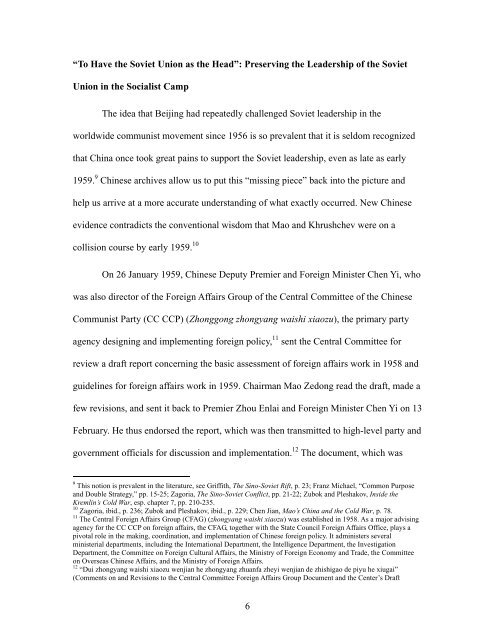The Quarrelling Brothers: New Chinese Archives and a ... - CiteSeerX
The Quarrelling Brothers: New Chinese Archives and a ... - CiteSeerX
The Quarrelling Brothers: New Chinese Archives and a ... - CiteSeerX
- No tags were found...
You also want an ePaper? Increase the reach of your titles
YUMPU automatically turns print PDFs into web optimized ePapers that Google loves.
“To Have the Soviet Union as the Head”: Preserving the Leadership of the SovietUnion in the Socialist Camp<strong>The</strong> idea that Beijing had repeatedly challenged Soviet leadership in theworldwide communist movement since 1956 is so prevalent that it is seldom recognizedthat China once took great pains to support the Soviet leadership, even as late as early1959. 9 <strong>Chinese</strong> archives allow us to put this “missing piece” back into the picture <strong>and</strong>help us arrive at a more accurate underst<strong>and</strong>ing of what exactly occurred. <strong>New</strong> <strong>Chinese</strong>evidence contradicts the conventional wisdom that Mao <strong>and</strong> Khrushchev were on acollision course by early 1959. 10On 26 January 1959, <strong>Chinese</strong> Deputy Premier <strong>and</strong> Foreign Minister Chen Yi, whowas also director of the Foreign Affairs Group of the Central Committee of the <strong>Chinese</strong>Communist Party (CC CCP) (Zhonggong zhongyang waishi xiaozu), the primary partyagency designing <strong>and</strong> implementing foreign policy, 11 sent the Central Committee forreview a draft report concerning the basic assessment of foreign affairs work in 1958 <strong>and</strong>guidelines for foreign affairs work in 1959. Chairman Mao Zedong read the draft, made afew revisions, <strong>and</strong> sent it back to Premier Zhou Enlai <strong>and</strong> Foreign Minister Chen Yi on 13February. He thus endorsed the report, which was then transmitted to high-level party <strong>and</strong>government officials for discussion <strong>and</strong> implementation. 12 <strong>The</strong> document, which was9 This notion is prevalent in the literature, see Griffith, <strong>The</strong> Sino-Soviet Rift, p. 23; Franz Michael, “Common Purpose<strong>and</strong> Double Strategy,” pp. 15-25; Zagoria, <strong>The</strong> Sino-Soviet Conflict, pp. 21-22; Zubok <strong>and</strong> Pleshakov, Inside theKremlin’s Cold War, esp. chapter 7, pp. 210-235.10 Zagoria, ibid., p. 236; Zubok <strong>and</strong> Pleshakov, ibid., p. 229; Chen Jian, Mao’s China <strong>and</strong> the Cold War, p. 78.11 <strong>The</strong> Central Foreign Affairs Group (CFAG) (zhongyang waishi xiaozu) was established in 1958. As a major advisingagency for the CC CCP on foreign affairs, the CFAG, together with the State Council Foreign Affairs Office, plays apivotal role in the making, coordination, <strong>and</strong> implementation of <strong>Chinese</strong> foreign policy. It administers severalministerial departments, including the International Department, the Intelligence Department, the InvestigationDepartment, the Committee on Foreign Cultural Affairs, the Ministry of Foreign Economy <strong>and</strong> Trade, the Committeeon Overseas <strong>Chinese</strong> Affairs, <strong>and</strong> the Ministry of Foreign Affairs.12 “Dui zhongyang waishi xiaozu wenjian he zhongyang zhuanfa zheyi wenjian de zhishigao de piyu he xiugai”(Comments on <strong>and</strong> Revisions to the Central Committee Foreign Affairs Group Document <strong>and</strong> the Center’s Draft6
















